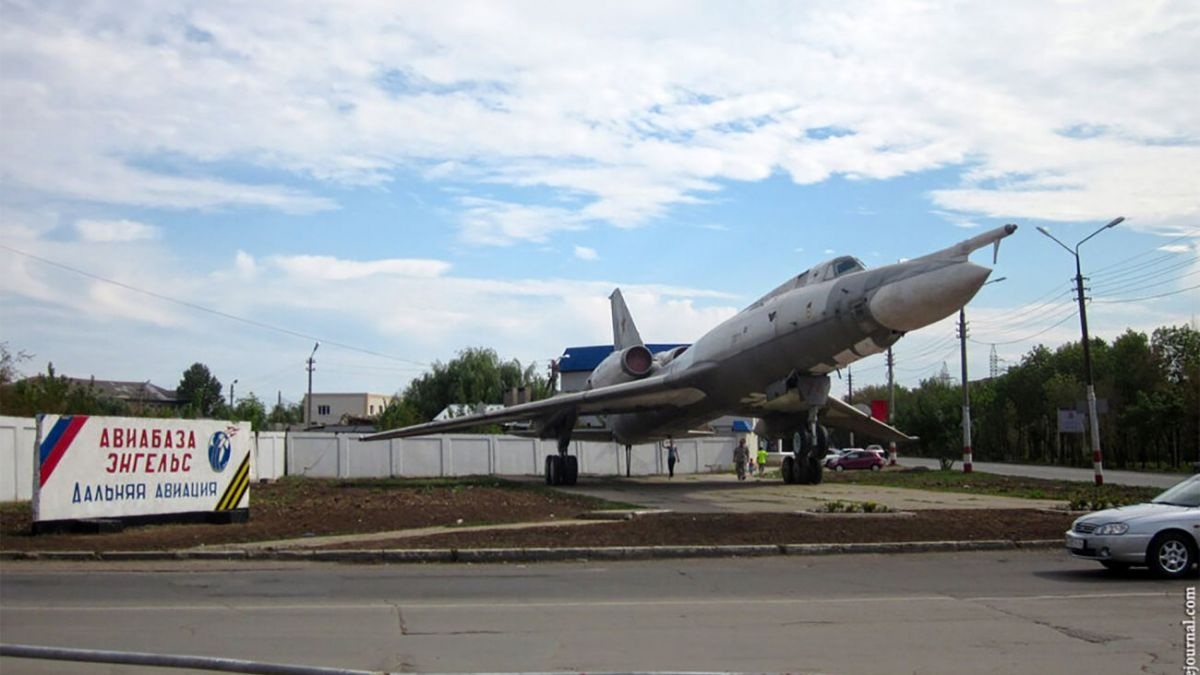News
New Drone, Same Message: Russia’s Airbase Under Pressure Yet Again

A recent video released by the independent Russian outlet Astra has brought renewed attention to ongoing drone attacks targeting Russia’s Engels strategic aviation base.
This facility, situated in Saratov Oblast, is a critical hub for Russia’s long-range bomber fleet, including the Tu-95MS and Tu-160 bombers that are frequently used for launching missile strikes against Ukraine.
Emergence of a New Drone Design
The latest footage highlights the appearance of unidentified strike drones with a design distinct from the widely recognized Liutyi kamikaze drones.
These new drones feature a straight-wing configuration and V-shaped tail fins, diverging from the delta or swept-wing designs commonly seen in prior attacks.
Close-up images suggest the power unit is mounted in the nose, and the landing gear is fixed rather than retractable.
This indicates a possible focus on simplicity and cost-effectiveness for repeated use or rapid production.
Attack Details and Immediate Impact
According to Astra and corroborating sources, these drones were observed targeting the Engels-2 airbase, with at least two drones reportedly shot down over the facility.
As of the latest reports, no major fires or explosions were detected at the airbase itself.
This is as confirmed by monitoring resources and NASA’s FIRMS satellite system, which specializes in fire detection.
Russian authorities have not reported significant damage to infrastructure or casualties among personnel in the immediate aftermath of this particular strike.
Context: Recent Strikes on Fuel Infrastructure
The Engels airbase has been a frequent target of Ukrainian drone operations, with a notable escalation in attacks on fuel storage facilities that support strategic aviation.
In January 2025, a massive fire erupted at the Kristall fuel depot, a critical Rosrezerv facility located approximately 8 kilometers from the airbase.
This depot stores and supplies specialized aviation fuel, particularly the T-8V grade used by Russia’s strategic bombers.
The attack on the Kristall plant resulted in multiple explosions and a large-scale blaze that burned for several days.
It caused logistical disruptions and reportedly reducing the operational capacity of the bombers stationed at Engels-2.
The fire was so extensive that local authorities declared an emergency, and two firefighters died while combating the blaze.
Satellite imagery confirmed that at least four fuel tanks were set ablaze, and the regional governor acknowledged significant damage to the facility.
Strategic Importance of Engels-2
Engels-2 is not just a military airfield; it is the principal base for Russia’s Tu-95MS and Tu-160 bombers.
Both play a central role in the country’s strategic deterrence and its ongoing campaign in Ukraine.
These aircraft require specialized fuel and maintenance infrastructure, making the supporting facilities, such as the Kristall depot, prime targets for Ukrainian strikes aimed at degrading Russia’s long-range strike capabilities.
The destruction of fuel reserves has a cascading effect: it can “ground” bombers by depriving them of necessary resources, delay sortie rates, and force Russia to reroute or resupply from less optimal locations, thereby reducing the tempo and reach of its air operations.
Russian Countermeasures and Ongoing Threats
In response to the persistent threat of drone attacks, Russian forces have implemented a range of defensive measures.
These include deploying air defense systems and even painting decoy silhouettes of bombers on the tarmac to mislead incoming drones.
However, the repeated success of Ukrainian drone strikes, including the latest incidents involving new drone types, suggests that these countermeasures have had limited effectiveness.
Wider Implications
The use of new, possibly domestically produced Ukrainian drones reflects ongoing innovation in Ukraine’s asymmetric warfare strategy.
By targeting logistics and support infrastructure rather than just aircraft, Ukraine aims to impose sustained operational and psychological costs on Russian strategic aviation.
The attacks also demonstrate the vulnerability of even well-defended bases to evolving drone technology and tactics.
In summary, the recent attacks on Engels, highlighted by Astra’s video, underscore the shifting dynamics of modern warfare.
One where low-cost, rapidly evolving drones can threaten even the most significant strategic assets.
The latest strike did not result in visible fires or destruction at the airbase.
On the other hand, the ongoing campaign against fuel and support facilities continues to erode Russia’s ability to project power from its most critical bomber base.
For Diaspora Digital Media Updates click on Whatsapp, or Telegram. For eyewitness accounts/ reports/ articles, write to: citizenreports@diasporadigitalmedia.com. Follow us on X (Fomerly Twitter) or Facebook












